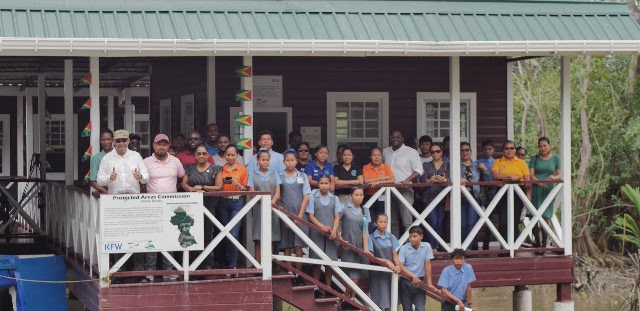The Protected Areas Commission (PAC) recently inaugurated the Moruca and Waini Research and Monitoring Station, marking a significant milestone in Guyana’s ongoing efforts to protect its endangered wildlife and fragile ecosystems.
Situated within the Shell Beach Protected Area—a 75-mile stretch of coastline vital for the conservation of four endangered turtle species—the new facility underscores the Government of Guyana’s commitment to environmental preservation. This strategic location will enhance the monitoring and research capabilities concerning the region’s rich marine and terrestrial biodiversity.
The development of the station was made possible through a collaborative effort between the Government of Guyana and the Government of Germany, with funding provided by the German Development Bank (Kreditanstalt für Wiederaufbau – KfW). The project saw an investment of $45 million, reflecting international confidence in Guyana’s conservation policies and practices.
Foreign Secretary at the Ministry of Foreign Affairs and International Cooperation, and Chairman of the PAC, Robert Persaud, emphasized the significance of this investment during the opening ceremony. “This investment by the German government reflects their confidence in Guyana’s policies and the dedication of this government towards ensuring that conservation efforts are paramount,” Persaud stated. He further noted that the station’s opening represents the government’s seriousness about protecting the country’s rich biodiversity.
The Moruca and Waini Research and Monitoring Station will be a hub for several key environmental bodies, including the Environmental Protection Agency (EPA), the Guyana Forestry Commission (GFC), and the World Wildlife Fund (WWF). These organizations will utilize the facility for real-time monitoring and extensive research of marine ecosystems.
Strategically positioned at the mouth of the Moruca River, the station is set to enhance monitoring of wildlife and human activities in the area. It also aims to serve as a focal point for international research, bolstering Guyana’s profile in global conservation efforts.
Persaud highlighted Guyana’s exemplary model of economic growth intertwined with natural resource preservation. “Guyana has demonstrated to the international community its strategic model for economic growth and advancement of natural resources, while ensuring that the necessary systems are in place to preserve and manage these resources,” he noted. The new station aligns with Guyana’s national forest conservation initiatives and its Low Carbon Development Strategy 2030 (LCDS 2030).
“We want to make this as part of our protected areas system a focal point for international research. And that is very crucial because as you look at how we have been able to mobilise the resources for a facility such as this is because of the worldwide recognition Guyana has won and continues to win because of our track record in environmental stewardship,” Persaud added.
The opening ceremony was attended by regional officials, local residents, and students from the Santa Rosa Secondary School, signifying the community’s engagement with the project. Persaud assured residents that the facility is designed to enhance local livelihoods through sustainable development initiatives, including research and ecotourism.
“Our government is committed to doing more, not only in terms of lifting the living conditions of our people and developing our resources, but also in ensuring the preservation and the sound management of our rich fauna and flora as we seek to project and continue to make Guyana a model,” Persaud emphasized.
The ceremony also featured notable attendees such as PAC Commissioner Jason Fraser, President of the Tourism and Hospitality Association of Guyana Omadele “Dee” George, Executive Director of Environmental Management Consultants (EMC) Shyam Nokta, and other officials from the PAC and regional authorities.
This development is part of the PAC’s broader strategy to achieve 30% environmental protection across Guyana’s land and marine ecosystems. The Moruca and Waini Research and Monitoring Station is expected to play a pivotal role in these efforts, contributing to the sustainable management and conservation of Guyana’s rich natural heritage.











